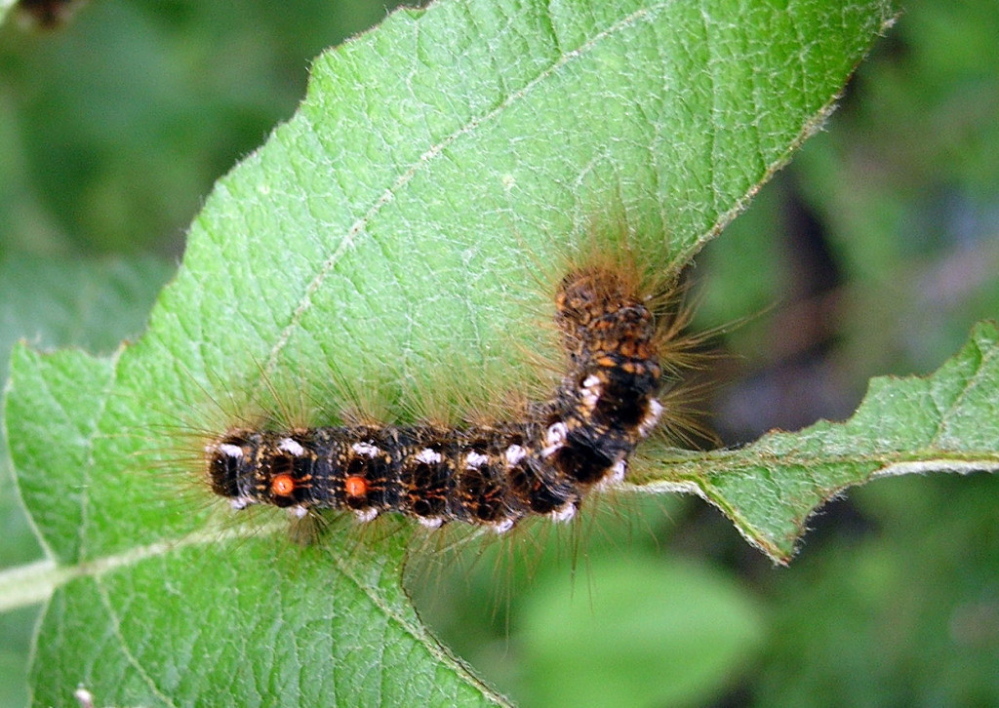An intense infestation of browntail moth caterpillars has hit midcoast Maine this year, triggering rashes or respiratory problems for hundreds of people who have come in contact with them or breathed in their microscopic poisonous hair fibers.
Brunswick, Freeport, Bath, Topsham and Bowdoinham are among the towns where state foresters have seen the most damage to trees, primarily the oaks and apples that the caterpillars favor.
The Kennebec Pharmacy in Brunswick has sold more than 500 of its own browntail moth spray, which is available by prescription, within the past two weeks.
“I can mix the compounds in my sleep. There has been a tremendous demand,” said Patrice Carter, the business’ pharmacist. “It’s very, very intense this year.”
Carter said 40 to 50 people per day have been coming into the pharmacy seeking relief from the rash caused by the invasive species.
By contrast, Carter said the pharmacy last year sold fewer than 500 prescriptions of the spray over the entire spring and summer.
The caterpillars have blanketed Wolfe’s Neck Woods State Park in Freeport to the point where park rangers have posted signs warning people to beware of the caterpillars, as well as the rashes and respiratory problems they can cause. Every visitor who arrived at the Wolfe’s Neck gate this year was told of the conditions, said park ranger Michael Frey.
“This is the worst we’ve ever seen it at the park,” he said. “The population has just exploded.”
Frey said the entire staff at Wolfe’s Neck has been affected by the caterpillars, although like any allergic reaction, it varies from person to person. Some people can get an itchy rash or have trouble breathing just by walking in the woods, while others exhibit no symptoms.
FUNGUS CAUSING SOME DIE-OFF
Frey said park visitors are advised that if they touch one of the caterpillars they should immediately wash the skin area with cold water and soap.
Frey said the caterpillars have started to die off, and rangers expect the problem to dissipate over the next few weeks.
But the caterpillars have been so numerous that the hair fibers they shed get everywhere and can float in the air for a while, causing respiratory problems, said Charlene Donahue, a Maine Forest Service entomologist. Treatments are similar to those for poison ivy.
“This is the most intense infestation I’ve seen since at least 2004. There was a lot of defoliation this year,” Donahue said. The caterpillars eat the leaves primarily on oak and apple trees, although they can infest other trees. “There were lots of trees with no leaves on them,” she said.
Donahue said there’s some good news: Many of the caterpillars died from a fungus, Entomophaga aulicae, which means that next year the population may be knocked back and the infestation may be smaller. It’s unclear what caused the browntail moth population to expand this year, but weather conditions must have been ideal for the moths in spring 2015, she said.
Visual surveys of winter webs in the past two years suggest the current infestation is the worst in more than a decade, but the reason for population surges is poorly understood because little scientific research has been done on the moths.
NO NATURAL PREDATORS, INFESTATION MAPPED
Browntail moths were accidentally introduced to the U.S. in 1897 and are usually located only in coastal southern Maine and on Cape Cod. The moth has no natural predators that can reduce its population.
“Birds for the most part don’t eat them,” Donahue said.
But the fungus may be a key to controlling the moth population, she said, and if the fungus’ range and prevalence can be expanded, that should help kill more moths.
Donahue said she will be seeking grant funding to research how the fungus might be used in the fight against the browntail moth, but she cautioned that much work still needs to be done. “That is just a dream right now,” she said.
Donahue said she surveyed 10,000 acres along the midcoast to gauge the extent of the damage, which she is currently mapping.
Even though the problem will be much less severe by mid-July because the caterpillars are dying off, Donahue said the fibers can persist and still cause a rash. She said people should be careful when doing yard work, and wear gloves when cleaning out areas that could have been infested by the moths. Also, any cocoons that are spotted should be wet down before being removed, she said.
Send questions/comments to the editors.





